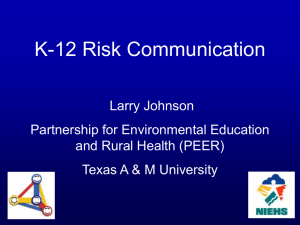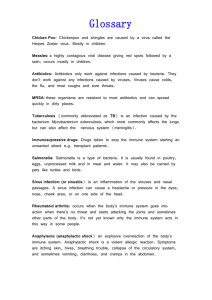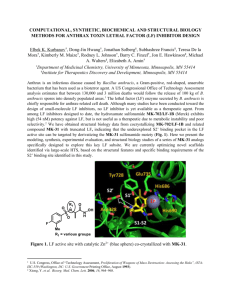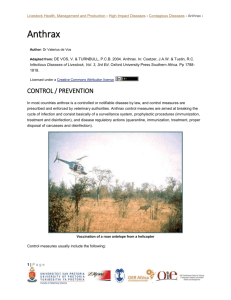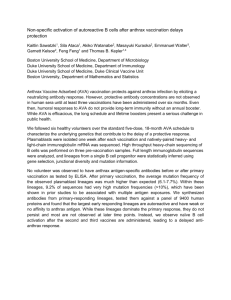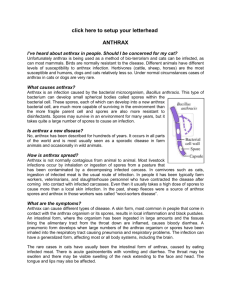Anthrax
advertisement
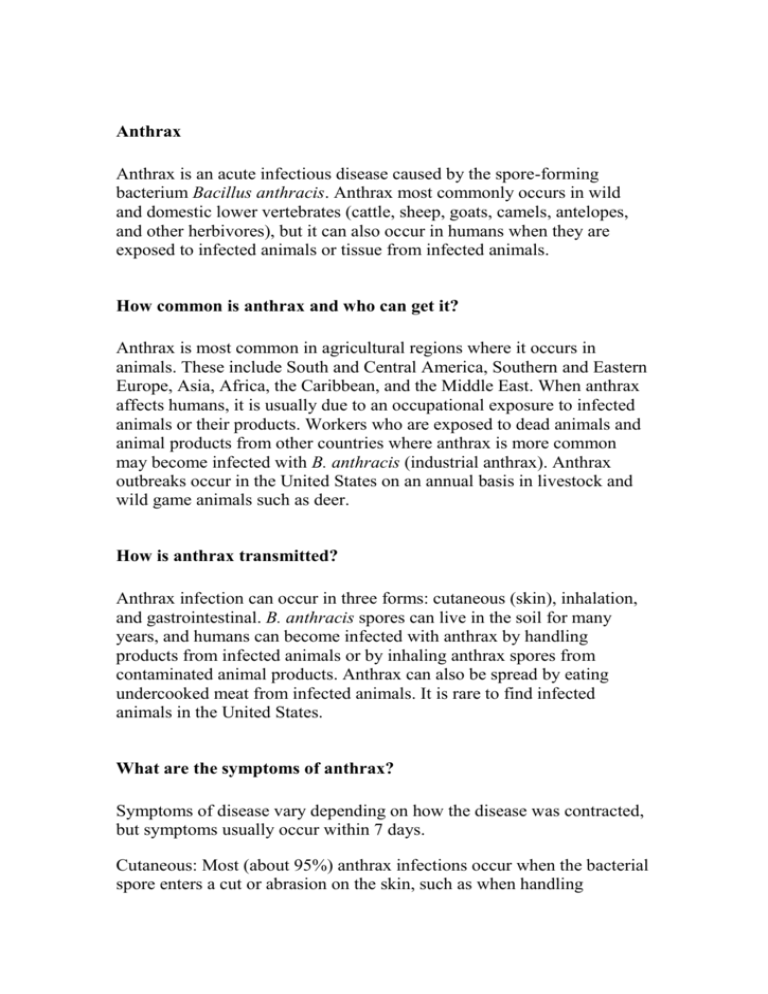
Anthrax Anthrax is an acute infectious disease caused by the spore-forming bacterium Bacillus anthracis. Anthrax most commonly occurs in wild and domestic lower vertebrates (cattle, sheep, goats, camels, antelopes, and other herbivores), but it can also occur in humans when they are exposed to infected animals or tissue from infected animals. How common is anthrax and who can get it? Anthrax is most common in agricultural regions where it occurs in animals. These include South and Central America, Southern and Eastern Europe, Asia, Africa, the Caribbean, and the Middle East. When anthrax affects humans, it is usually due to an occupational exposure to infected animals or their products. Workers who are exposed to dead animals and animal products from other countries where anthrax is more common may become infected with B. anthracis (industrial anthrax). Anthrax outbreaks occur in the United States on an annual basis in livestock and wild game animals such as deer. How is anthrax transmitted? Anthrax infection can occur in three forms: cutaneous (skin), inhalation, and gastrointestinal. B. anthracis spores can live in the soil for many years, and humans can become infected with anthrax by handling products from infected animals or by inhaling anthrax spores from contaminated animal products. Anthrax can also be spread by eating undercooked meat from infected animals. It is rare to find infected animals in the United States. What are the symptoms of anthrax? Symptoms of disease vary depending on how the disease was contracted, but symptoms usually occur within 7 days. Cutaneous: Most (about 95%) anthrax infections occur when the bacterial spore enters a cut or abrasion on the skin, such as when handling contaminated wool, hides, leather or hair products (especially goat hair) of infected animals. Skin infection begins as a raised itchy bump that resembles an insect bite but within 1-2 days develops into a vesicle and then a painless ulcer, usually 1-3 cm in diameter, with a characteristic black necrotic (dying) area in the center. Edema or swelling of the surrounding tissues may develop and lymph glands in the adjacent area may swell. About 20% of untreated cases of cutaneous anthrax will result in death. Deaths are rare with appropriate antimicrobial therapy. Inhalation: Initial symptoms may resemble a common cold. After several days, the symptoms may progress to severe breathing problems and shock. Inhalation anthrax is usually fatal, and even with aggressive antibiotic and supportive therapy 45% of inhalation anthrax cases were fatal in the bioterrorist attack in the fall of 2001. Intestinal: The intestinal disease form of anthrax may follow the consumption of contaminated meat and is characterized by an acute inflammation of the intestinal tract. Initial signs include nausea, loss of appetite, vomiting, fever are followed by abdominal pain, vomiting of blood, and severe diarrhea. Symptoms may also include lesions and soreness in the throat, difficulty swallowing, marked swelling of the neck and regional lymph glands. Intestinal anthrax results in death in 25% to 60% of cases. Where anthrax is usually found? Anthrax can be found globally. It is more common in developing countries or countries without veterinary public health programs. Certain regions of the world (South and Central America, Southern and Eastern Europe, Asia, Africa, the Caribbean, and the Middle East) report more anthrax in animals than others. Can anthrax be spread from person-to-person? Person-to-person transmission is extremely unlikely and has only reported with cutaneous anthrax, where discharges from skin lesions are potentially infectious. Communicability is not a concern in managing or visiting with patients with inhalation anthrax. Is there a way to prevent infection? In countries where anthrax is common and vaccination levels of animal herds are low, humans should avoid contact with livestock and animal products and avoid eating meat that has not been properly slaughtered and cooked. Also, an anthrax vaccine has been licensed for use in humans. The vaccine is reported to be 93% effective in protecting against anthrax. anthrax vaccine The anthrax vaccine is manufactured and distributed by BioPort, Corporation, Lansing, Michigan. The vaccine is a cell-free filtrate vaccine, which means it contains no dead or live bacteria in the preparation. The final product contains no more than 2.4 mg of aluminum hydroxide as adjuvant. Anthrax vaccines intended for animals should not be used in humans. Who should get vaccinated against anthrax? The Advisory Committee on Immunization Practices has recommended anthrax vaccination for the following groups: Persons who work directly with the organism in the laboratory Persons who work with imported animal hides or furs in areas where standards are insufficient to prevent exposure to anthrax spores. Persons who handle potentially infected animal products in highincidence areas. (Incidence is low in the United States, but veterinarians who travel to work in other countries where incidence is higher should consider being vaccinated.) Military personnel deployed to areas with high risk for exposure to the organism (as when it is used as a biological warfare weapon). What is the protocol for anthrax vaccination? The immunization consists of three subcutaneous injections given 2 weeks apart followed by three additional subcutaneous injections given at 6, 12, and 18 months. Annual booster injections of the vaccine are recommended thereafter. Are there adverse reactions to the anthrax vaccine? Mild local reactions occur in 30% of recipients and consist of slight tenderness and redness at the injection site. Severe local reactions are infrequent and consist of extensive swelling of the forearm in addition to the local reaction. Systemic reactions occur in fewer than 0.2% of recipients. How is anthrax diagnosed? Anthrax is diagnosed by culture and isolation of the causative bacterium, B. anthracis; by detecting the bacterial DNA or antigens; or by measuring specific antibodies in the blood of persons with suspected cases. The bacteria can be cultured from the blood, skin lesions, fluid from the lungs or respiratory secretions, spinal fluid, or other affected tissues prior to the start of antibiotic treatment. Detection of the DNA or antigens of the bacteria, and detection of antibodies in the blood of suspected cases, are important tools for diagnosis because positive culture is unlikely after antibiotic treatment has been started. Is there a treatment for anthrax? Doctors can prescribe effective antibiotics. To be effective, treatment should be initiated early. If left untreated, the disease can be fatal.


